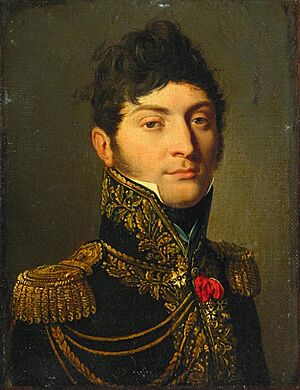Géraud Duroc facts for kids
Quick facts for kids
Géraud Duroc
Duke of Frioul
|
|
|---|---|

Portrait by Louis-Léopold Boilly
between 1806 and 1809 |
|
| Born | 25 October 1772 Pont-à-Mousson, France |
| Died | 23 May 1813 (aged 40) Markersdorf, Saxony |
| Buried | |
| Allegiance | |
| Service/ |
Army |
| Years of service | 1792–1813 |
| Rank | General of division |
| Battles/wars | French Revolutionary Wars Napoleonic Wars † |
| Awards | Grand Eagle of the Legion of Honor Grand Cross of the House Order of Fidelity Grand Cross of the Order of the Black Eagle Duke of the Empire |
| Other work | Grand marshal of the palace Member of the Sénat conservateur |
Géraud Christophe Michel Duroc (born du Roc; 25 October 1772 – 23 May 1813) was a French general and diplomat. He fought in the French Revolutionary Wars and the Napoleonic Wars. Duroc was well-known for his close friendship with Napoleon Bonaparte. Napoleon made him the first Grand marshal of the palace. This was a very important job, as he was in charge of the Emperor's military household.
Contents
Early Life and Military Training
Duroc was born in Pont-à-Mousson, France, on October 25, 1772. His family was part of the French nobility. His father, Claude du Roc, was a former captain of dragoons, which were soldiers who rode horses.
In 1781, Duroc started at a military school in his hometown. He studied there for eight years. In March 1792, he joined the School of Artillery in Châlons. Around this time, he changed his last name from "du Roc" to "Duroc." This was because of the French Revolution, when many noble titles and names were changed.
Joining and Leaving the Royalist Army
At first, Duroc was against the new revolutionary government in France. In July 1792, he left the artillery school. He became a soldier in the counter-revolutionary Army of Condé. This army was made up of people who had left France to fight against the Revolution.
However, Duroc soon changed his mind. After the Battle of Valmy, he left the royalist army. He was arrested by the French, but in March 1793, he was allowed to finish his education.
Serving in the Revolutionary Wars
Duroc officially joined the French Revolutionary Army on June 1, 1793. He quickly moved up in rank. In 1796, Captain Duroc became an aide-de-camp to Napoleon. An aide-de-camp is like a personal assistant to a general. Duroc showed great bravery in battles in Italy between 1796 and 1797.
He also served in Napoleon's campaign in Egypt and Syria. He was badly hurt at the Battle of Abukir. Because of his loyalty to Napoleon, he earned Napoleon's full trust. He became Napoleon's chief aide-de-camp in 1798. Later, he became a general and the governor of the Tuileries Palace. After the Battle of Marengo, Duroc was sent on important diplomatic missions to other countries.
Role in the Napoleonic Wars

As the Grand Marshal of the Palace, Duroc had a very important job. He was in charge of Napoleon's personal safety. He also managed all the small details of the Emperor's household. This included everything from security to daily arrangements.
After the Battle of Austerlitz, Duroc took part in important talks. He negotiated with leaders like Frederick William III of Prussia and the elector of Saxony. He also helped bring some states into the Confederation of the Rhine. In 1809, he helped arrange a ceasefire called the armistice of Znaim.
In 1808, Napoleon made him the Duke of Frioul. This was a special title. In 1813, after the difficult Russian campaign, he was also appointed to the Sénat conservateur, which was a high-ranking political group.
Duroc's Final Battle
After the Battle of Bautzen in May 1813, Napoleon's army was chasing the enemy. On May 22, 1813, at the Battle of Reichenbach, a cannonball hit a tree and then struck Duroc. He was severely wounded. Napoleon was nearby and saw what happened.
Duroc was taken to a nearby farmhouse. He asked for Napoleon to come to him. He told Napoleon he was sorry he could not serve him anymore. He also asked Napoleon to look after his daughter. Then, he asked Napoleon to leave so he would not see him die. Napoleon was very sad about losing his friend. He later bought the farm where Duroc died and built a monument there.
Legacy and Remembrance

In 1847, Duroc's remains were moved to Les Invalides in Paris. This is a famous place where many French military heroes are buried. His name is also carved on the Eastern pillar of the Arc de Triomphe in Paris.
The Duroc metro station in Paris is named after him.


